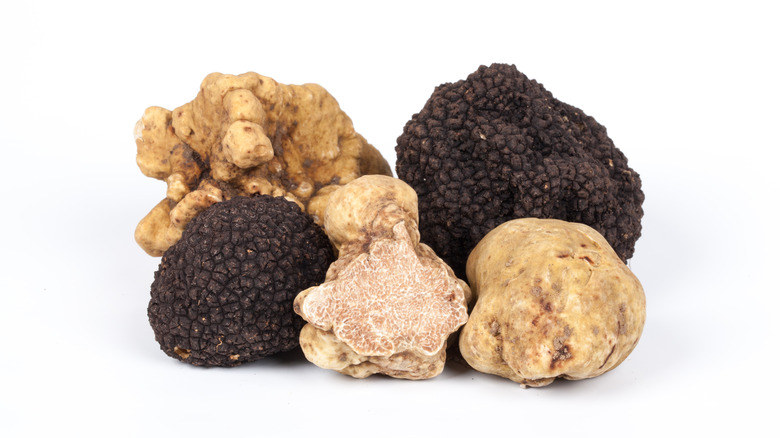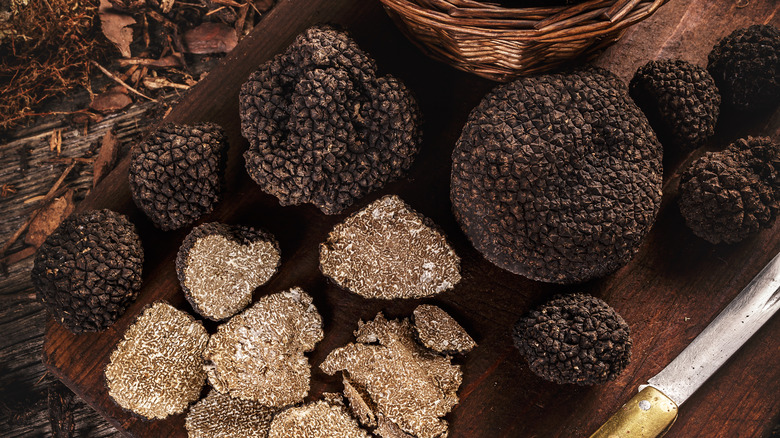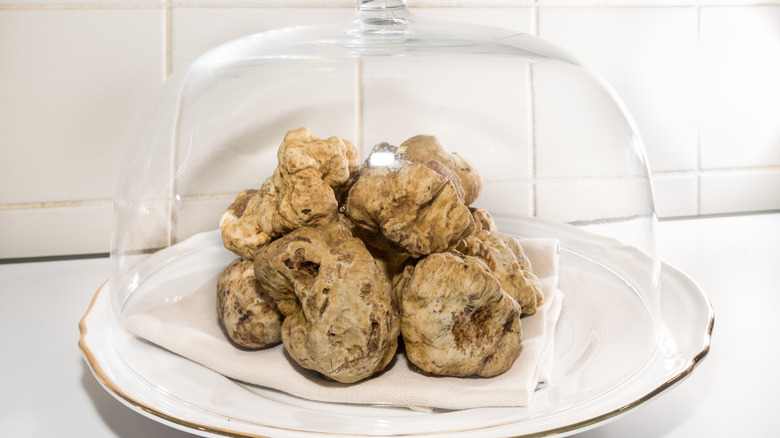The Difference Between White And Black Truffles
When it comes to fungi, there are creminis, portobellos, shiitakes, and porcinis, and then there are truffles. Mushrooms and truffles are cousins, but the latter can exist only by attaching themselves to the roots of certain trees, some of which are oak, hazel, and beech, per Smithsonian. Trees use the truffles to help extract minerals from the soil, and the tree's roots keep truffles alive by passing on nutrients in a relationship known as mycorrhiza per Food Unfolded.
Truffles have been enjoyed for centuries; Lit Hub notes that the Greeks believed truffles were born when lightning hit trees and traveled down to its roots. The Greek philosopher Plutarch keenly posited that when the earth was soaked with rain, it created a truffle, "which is not like a plant, having neither roots nor sprouts, but is a being in itself, having the consistency of earth that has been slightly altered." The article further explains that the truffle was referred to as "the Mozart of mushrooms" by Italian composer Gioachino Rossini and "the holy of holies" by writer Alexandre Dumas.
Smithsonian says there are about 180 types of truffles that we know of today, but chefs have found only 13 of them to be of any culinary use. Of these, the black truffle from France, and the white truffle from Italy are considered to be the most expensive truffles on the market.
What are black truffles
If you've ever had a black truffle, chances are you had the Tuber melanosporum, aka the Périgord black truffle, aka the "queen of truffles," per Ostalaritza Leioa Hosterleria. Eataly describes the black truffle as "earthy and robust," and it's a flavor so sought after that it has been replicated using synthetic ingredients to include in everything from cooking oil to potato chips.
Black truffles were once only found in European regions close to the Mediterranean, like Spain and France, per Truff. But cultivation has made it possible for the black truffle to take root in other parts of the world, including Australia and New Zealand, per Food, as well as in the U.S., China, Chile, and Argentina, per Smithsonian.
Growing black truffles still present a unique set of challenges for the farmers that attempt it. The weather and soil conditions need to be precisely what a truffle needs for it to grow. Farmers then inject truffle spores into the roots of host trees and hope these take root — and if they do, Food says black truffles can be had six to seven years after the process. Because it is more readily available, black truffles can cost between $300 to $800 per pound, per Martha Stewart. Once harvested, the Independent says they can be eaten for up to a week.
What are white truffles
There is nothing quite like the white truffle, which looks a bit like a wilted potato, but with a pungent flavor and aroma, which one British journalist described as "halfway between that of a smoked cheese and strong mushroom," per Independent.
Like the black truffle, the white can only grow with the help of the roots of specific trees like oak, chestnut, and linden. But the white truffle is far more temperamental; it cannot be cultivated, and it can only be found in a Northern Italian forest called Langhe between September to December, according to Eataly. It's little wonder, then, that gourmet chefs will shell out up to $4,000 per pound for fresh white truffle (via Martha Stewart).
Bon Appétit warns white truffles don't keep for very long, shorter even than the black truffle. They begin to degrade as soon as they are plucked out of the ground and have been known to last five days, but we don't suggest pushing it. In one memorable incident in 2004, a 1 lb 14 oz white truffle was delivered to London's Michelin-starred Italian restaurant, Zafferano. They saved the truffle in the refrigerator for four days, presumably for the busy weekend. But when they were finally ready to serve the white truffle, to their horror, it had gone bad, and the restaurant had to write off the ingredient, which had cost them $34,370 to acquire, per Independent.


